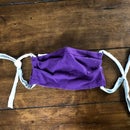Introduction: All-Natural Cabbage Dye
You can use the color-changing (magical?) properties of red cabbage to make a vibrant, natural dye in many different colors. I particularly like the bright blue!
Step 1: Gather Your Materials
Dye materials:
Red cabbage
Salt
pH adjuster (none needed for purple dye, vinegar for pink, baking soda for blue and green)
Other materials:
Rubber bands
Cloth to dye (I used a large white t-shirt)
Step 2: Chop Cabbage
Using a sharp knife, roughly dice the cabbage into one-inch pieces.
Step 3: Cook Cabbage
Transfer the cabbage to a large pot. Cover it with a few cups of water and sprinkle the top with a layer of salt. The measurements here don't need to be exact, but I used about 3 tablespoons of salt. Boil over high heat for 4-8 hours, or until the mixture has reduced by nearly half and the cabbage has released as much moisture as possible.
Step 4: Strain Cabbage
After cooking, the liquid in the pot should be highly pigmented. Using a sieve, press down on the cabbage to squeeze out as much liquid as possible. Save the dye, but discard (or compost) the leftover cabbage.
Step 5: Adjust PH
By itself, the cabbage liquid is a pretty purple color. Acidic vinegar turns the dye pink, while adding alkaline baking soda turns the dye a blue color. If enough baking soda is added, the blue dye will dry a greenish color.
The blue dye was my favorite, so that's what I decided to go with. There's no exact amount for the baking soda, so just add a teaspoon at a time until the dye just starts to lose it's purple tinge.
While the dye doesn't look super vivid at this point, the color will come through by the end.
Step 6: Prepare Cloth
You don't have to fold your cloth, but I used my favorite tie dye technique to showcase the blue pigment.
To do this triangle design, fold the shirt like an accordion until it becomes one long strip, then fold the strip into triangles. By the end, you should have one thick triangle.
Wrap rubber bands over the two side corners of the triangle, as shown above.
Step 7: Dye and Wait
Pour the dye over your cloth, cover it with plastic wrap, and let sit for at least 24 hours. If your cloth is not fully submerged, flip it over halfway through.
Step 8: Rinse and Enjoy!
After soaking, rinse any excess dye or cabbage particles that might be on your cloth. At first, the color may look a bit dull, but once you start rinsing and unfolding it, the bright color will start to come through.
I was shocked at how bright the color looked once I went outside! You can really see how vibrant it is in the natural light.






